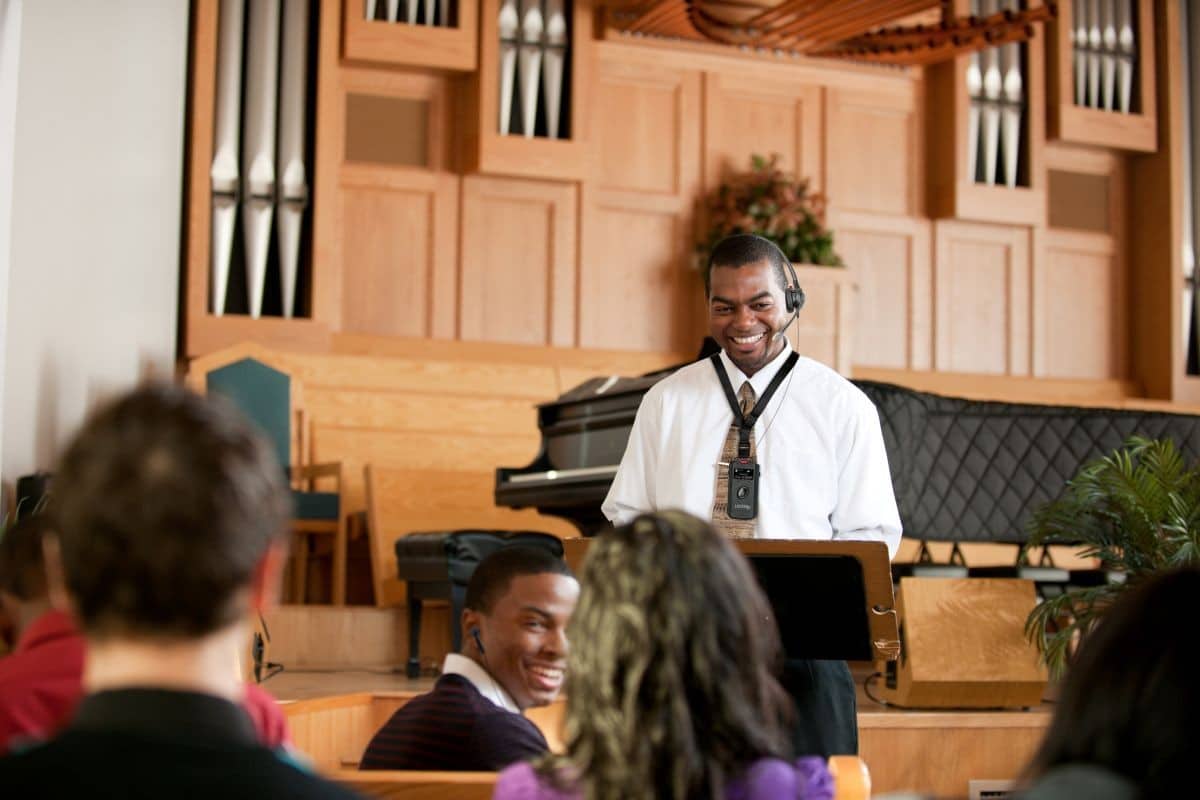Mention “two-way radio communication,” and people will likely think of the walkie-talkies they played with in childhood. They might imagine military personnel and law enforcement officers issuing orders via rugged handheld devices or units clipped on their shoulder lapels.
They might not think of using two-way communication systems in a house of worship, but this technology can support communication in worship facilities in many ways.
How Mobile, Two-Way Communication Systems Facilitate Communication
First, let’s break down the technology and how it functions. Two-way communication systems designed for assistive listening and supplemental audio consist of a transmitter or transceiver unit (hybrid transmitter and receiver that can transmit and receive audio). Users wear the small, lightweight unit on a lanyard around their necks and hear audio through connected earbuds or headphones.
If they have hearing aids with telecoils, users can borrow a neck loop lanyard to transmit audio from the transceiver to their hearing aids. The neck loop is a miniature version of an induction loop-based assistive listening system that would be installed around the perimeter of a space.
One transceiver is designated as the leader unit and is paired with other transceivers. Transceiver units can be grouped simultaneously in a charging tray. They can also be paired one-to-one using near-field communication technology. Users tap their transceiver to the leader unit and are paired.
When the person with the leader unit speaks into a headset mic, others in the group hear them. The leader can select one-way or two-way communication.
In the former mode, group members hear the leader but can’t respond. In the latter mode, group members hear the leader and can respond by pressing and holding the “talk” button on their transceiver.
Applications for Mobile, Two-Way Communication Systems in Worship Environments
The two-way communication systems are easy to use, but why and when would anyone in a worship facility use them?
Here are a few applications of the technology in worship environments:
Assistive Listening
Hearing clearly in houses of worship can be challenging. Worshippers may have hearing loss. They may be seated near a chatty toddler, under a loud fan, or in the back of a space beyond the speaker system range. Maybe cavernous ceilings, marble floors, and annexed spaces swallow or distort sound.
With two-way communication systems, listeners can hear clear audio regardless of these challenges. They can borrow a transceiver paired with a speaker’s transceiver (the “speaker” could be the minister, a transceiver and microphone positioned in front of the choir, etc.) and hear audio directly in their ears via connected headphones or earbuds. Ambient sounds are filtered out, so the listener can focus on the audio they want to hear, not distracting background noise.
If a house of worship already has an assistive listening system, a two-way communication system can supplement and extend it. Maybe the existing system is a hearing loop or infrared-based technology in the main sanctuary that doesn’t reach worshippers in cry rooms or other nearby spaces where “overflow” services happen. A mobile, two-way communication system could extend assistive listening in these instances.
It could also be used in spaces that might not have (or typically need) installed assistive listening, including administrative offices and confessional booths. With a mobile, two-way communication system, people can use transceivers with headsets to hear better in these spaces and during Bible studies, book clubs, counseling sessions, support group meetings, retreats, and other church-related activities outside the main sanctuary.
The mobile units can provide assistive listening away from church property, as well. Examples include ministry visits to nursing homes, hospitals, and detention centers.
Interpretation
A mobile, two-way communication system facilitates interpretation so language doesn’t have to be a barrier to worshippers fully engaging in services. An interpreter can hear what the primary speaker is saying and relay the message in another language using a single transceiver and headset with an integrated microphone. The interpreter does not need to manage multiple headsets, transmitters, and receivers, which is often the case with traditional interpretation delivery systems.
A two-way system’s broad range means an interpreter can listen to the primary speaker in another room and speak freely for listeners in the group to hear, without distracting anyone. Multiple groups can function in the same space simultaneously, meaning several interpreters could listen to primary speakers and relay messages in different languages to members of their group at the same time. The system can support interpretation during worship services and events at the church, and on pilgrimages and mission trips abroad.
Behind the Scenes
A mobile, two-way communication system can be useful in producing events and coordinating logistics at worship facilities. For example, an event coordinator could use the system to communicate with food servers, members of the security team, and parking and traffic control leaders during a church fundraiser or other community event.
Directors could use the system to communicate with stage managers and AV team members working behind the scenes at a Christmas performance or other church production.
The system could also facilitate employee and volunteer training and facilities tours.
In worship facilities affiliated with schools, mobile, two-way communication systems can provide assistive listening support and facilitate communication for students, educators, and coaches inside and outside classrooms.
The scratchy audio and clunky transmitters associated with the walkie-talkies from childhood have their place, but houses of worship and associated facilities are not it. Fortunately, two-way communication systems and technology have advanced significantly.
There are many applications for mobile, two-way communication systems in worship centers. How will you use a system to help worshippers hear better and engage more fully in fellowship and ministry events your community offers?
Mikey Shaffer is senior director of sales at Listen Technologies, a leading provider of advanced wireless listening solutions for 26 years. Listen Technologies’ solutions include ListenTALK, an award-winning, mobile, two-way communication system that helps people communicate clearly in any environment, www.listentech.com.











